
Different types of railroad rolling stock have different couplers depending on the purpose and type of equipment being used and its intended destination. European rolling stock tend to use buffers and chain couplers while American rolling stock uses a Janney coupler or "knuckle coupler". These are incompatible with each other, but where some railroads have obtained older, less expensive used rolling stock from different countries or regions, instead of having to standardize on one form of coupler, it may be useful to be able to use either type of coupler on a piece of rolling stock without having to remove anything.
It is possible to mount both buffers and chain and knuckle couplers on the same car, provided that the knuckle can swing out of the way. Alternatively, either a lug to hold the chain is cast in the body of the coupler or a chain is mounted on top of the coupler. This is also done with an SA3 coupler built by SAB WABCO.[1]
Locomotives and some freight cars of the Indian Railways are fitted with a 'transition coupler' that incorporates a screw coupling within a knuckle coupler: the knuckle coupler remains in position and does not swing away when not in use. The screw coupling is mounted on a hinge on the opposite side of the knuckle coupler. Most Indian freight cars use the knuckle coupler alone, without buffers, whereas passenger coaches almost exclusively use screw couplers and buffers. Exceptions are the new LHB coaches imported from Europe, and a few other makes of carriages converted to use knuckle couplers.[2][3]
Some Russian locomotives and wagons have buffers together with the central coupler. When coupling to Finnish equipment, a short chain with a block that fits in the central coupler is placed on the Russian side, backing up and compressing the buffers so that the chain can be laid on the hook. (That is also the common way of coupling locomotives to or from wagons, faster than unscrewing the link.)
British locomotive-hauled passenger carriages adopted a dual coupling system in the 1950s. They have retractable buffers and a central Buckeye automatic knuckle coupler that lowers to reveal a hook for a screw-type chain coupling. When in use, a pin through the buckeye shank rests in the conventional hook. No chain is provided on dual-coupled vehicles, since the chain on the other vehicle can be used when the knuckle coupler is out of the way (down). Inter-stock coupling was with the automatic coupler (with the buffers retracted), while connection to the locomotive was with the buffer-and-chain system with a screw coupler. Today this dual coupling system has been adopted for all loco-hauled passenger trains in Great Britain to allow faster shunting operations.
Gallery
- Indian and British dual couplings with buffers
 Dual coupling on a modern locomotive. (Indian locomotive class WAG-9) The chain is mounted on a hinge on the right of the AAR coupler
Dual coupling on a modern locomotive. (Indian locomotive class WAG-9) The chain is mounted on a hinge on the right of the AAR coupler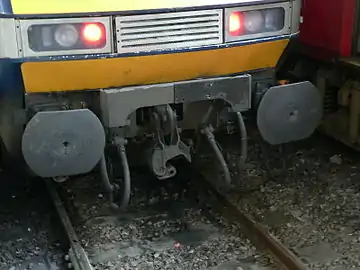 British-style dual buffer-and-chain/semi automatic coupler with knuckle swung out of the way (drop head)
British-style dual buffer-and-chain/semi automatic coupler with knuckle swung out of the way (drop head) Mark 1 coach fitted with dual buffer-and-chain/janney coupler, knuckle is swung out of the way
Mark 1 coach fitted with dual buffer-and-chain/janney coupler, knuckle is swung out of the way Prototype Mark 2 13252 fitted with dual buffer-and-chain/janney coupler at the Mid-Norfolk Railway in April 2009
Prototype Mark 2 13252 fitted with dual buffer-and-chain/janney coupler at the Mid-Norfolk Railway in April 2009
- Dual couplings and adapters
 Coupling adapter for use between Janney coupler on a locomotives and WABCO-2 couplers fitted to commuter rail multiple units at New York's Pennsylvania Station. The adapter is seen from the bottom
Coupling adapter for use between Janney coupler on a locomotives and WABCO-2 couplers fitted to commuter rail multiple units at New York's Pennsylvania Station. The adapter is seen from the bottom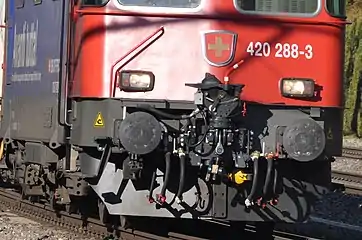 Hybrid coupler allowing automatic as well as buffer-and-chain couplings on Swiss Re 420 locomotives
Hybrid coupler allowing automatic as well as buffer-and-chain couplings on Swiss Re 420 locomotives A Finnish locomotive with dual coupling {Unilink coupler)
A Finnish locomotive with dual coupling {Unilink coupler) JNR Class EF81 the AAR coupler on the right (far side) of the Shibata coupler. The Janney coupler is shown in position on the centerline and the Shibata coupler is shown as swung out of the way. There is a pivot in common allowing both to swing.
JNR Class EF81 the AAR coupler on the right (far side) of the Shibata coupler. The Janney coupler is shown in position on the centerline and the Shibata coupler is shown as swung out of the way. There is a pivot in common allowing both to swing.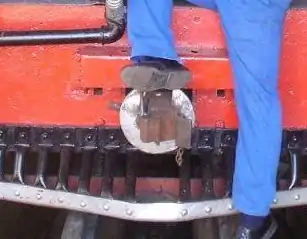
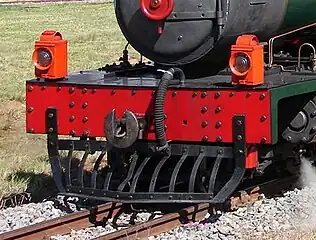 Bell-and-hook coupler with Johnston coupler adapter link
Bell-and-hook coupler with Johnston coupler adapter link Willison coupler adapter for bell-and-hook couplers
Willison coupler adapter for bell-and-hook couplers.jpg.webp) A Janney coupler adapter installed on a Scharfenberg coupler
A Janney coupler adapter installed on a Scharfenberg coupler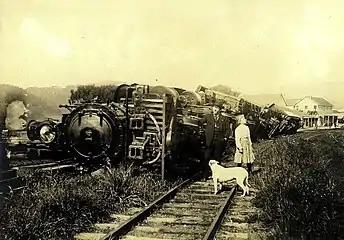 This locomotive was derailed by the 1906 San Francisco earthquake. The locomotive had three link and pin coupler pockets for moving standard and narrow gauge cars.
This locomotive was derailed by the 1906 San Francisco earthquake. The locomotive had three link and pin coupler pockets for moving standard and narrow gauge cars. Transition era AAR knuckle coupler. The gap in the knuckle accommodates the link of a link and pin coupler or a Johnston coupler and the vertical hole in the knuckle accommodates the pin of either coupler.
Transition era AAR knuckle coupler. The gap in the knuckle accommodates the link of a link and pin coupler or a Johnston coupler and the vertical hole in the knuckle accommodates the pin of either coupler.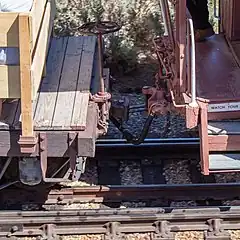 Dual coupling between link & pin system with a knuckle coupler. The knuckle component has been removed, allowing a pin to drop in the vertical hole in the head to mate with the link forming an ad-hoc coupler.
Dual coupling between link & pin system with a knuckle coupler. The knuckle component has been removed, allowing a pin to drop in the vertical hole in the head to mate with the link forming an ad-hoc coupler.
See also
References
- ↑ SAB WABCO C-AK Archived 2009-05-19 at the Wayback Machine
- ↑ Coupler conversion
- ↑ "Centre Buffer Coupler of AAR type". Archived from the original on 2014-02-21. Retrieved 2014-04-29.